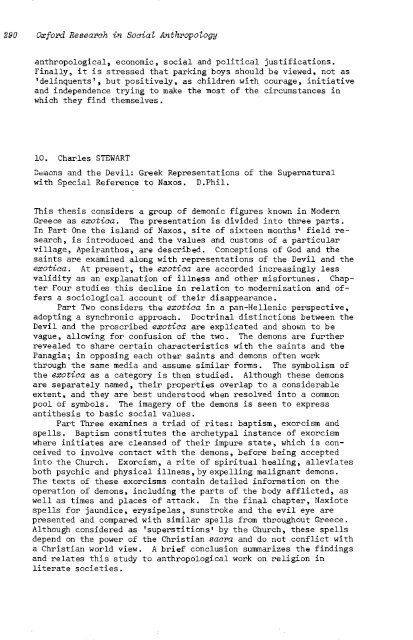CONTENTS NO.I - Institute of Social and Cultural Anthropology ...
CONTENTS NO.I - Institute of Social and Cultural Anthropology ...
CONTENTS NO.I - Institute of Social and Cultural Anthropology ...
Create successful ePaper yourself
Turn your PDF publications into a flip-book with our unique Google optimized e-Paper software.
290 Oxfo~d ReBea~ah in SoaiaZ Anth~opoZogy<br />
anthropological, economic, social <strong>and</strong> political justifications.<br />
Finally, it is stressed that parking boys should be viewed, not as<br />
'delinquents', but positively, as children with courage, initiative<br />
<strong>and</strong> independence trying to make the most <strong>of</strong> the circumstances in<br />
which they find themselves.<br />
10. Charles STEWART<br />
Demons <strong>and</strong> the Devil: Greek Representations <strong>of</strong> the Supernatural<br />
with Special Reference to Naxos. D.Phil.<br />
This thesis considers a group <strong>of</strong> demonic figures known in Modern<br />
Greece as exotiaa. The presentation is divided into three parts.<br />
In Part One the isl<strong>and</strong> <strong>of</strong> Naxos, site <strong>of</strong> sixteen months' field research,<br />
is introduced <strong>and</strong> the values <strong>and</strong> customs <strong>of</strong> a particular<br />
village, Apeiranthos, are described. Conceptions <strong>of</strong> God <strong>and</strong> the<br />
saints are examined along with representations <strong>of</strong> the Devil <strong>and</strong> the<br />
exotiaa. At present, the exotiaa are accorded increasingly less<br />
validity as an explanation <strong>of</strong> illness <strong>and</strong> other misfortunes. Chapter<br />
Four studies this decline in relation to modernization <strong>and</strong> <strong>of</strong>fers<br />
a sociological account <strong>of</strong> their disappearance.<br />
Part Two considers the exotiaa in a pan-Hellenic perspective,<br />
adopting a synchronic approach. Doctrinal distinctions between the<br />
Devil <strong>and</strong> the proscribed exotiaa are explicated <strong>and</strong> shown to be<br />
vague, allowing for confusion <strong>of</strong> the two. The demons are further<br />
revealed to share certain characteristics with the saints <strong>and</strong> the<br />
Panagia; in opposing each other saints <strong>and</strong> demons <strong>of</strong>ten work<br />
through the same media <strong>and</strong> assume similar forms. The symbolism <strong>of</strong><br />
the exotiaa as a category is then studied. Although these demons<br />
are separately named, their properties overlap to a considerable<br />
extent, <strong>and</strong> they are best understood when resolved into a common<br />
pool <strong>of</strong> symbols. The imagery <strong>of</strong> the demons is seen to express<br />
antithesis to basic social values.<br />
Part Three examines a triad <strong>of</strong> rites: baptism, exorcism <strong>and</strong><br />
spells. Baptism constitutes the archetypal instance <strong>of</strong> exorcism<br />
where initiates are cleansed <strong>of</strong> their impure state, which is conceived<br />
to involve contact with the demons, before being accepted<br />
into the Church. Exorcism, a rite <strong>of</strong> spiritual healing, alleviates<br />
both psychic <strong>and</strong> physical illness, by expelling malignant demons.<br />
The texts <strong>of</strong> these exorcisms contain detailed information on the<br />
operation <strong>of</strong> demons, including the parts <strong>of</strong> the body afflicted, as<br />
well as times <strong>and</strong> places <strong>of</strong> attack. In the final chapter, Naxiote<br />
spells for jaundice, erysipelas, sunstroke <strong>and</strong> the evil eye are<br />
presented <strong>and</strong> compared with similar spells from throughout Greece.<br />
Although considered as 'superstitions' by the Church, these spells<br />
depend on the power <strong>of</strong> the Christian Baa~a <strong>and</strong> do not conflict with<br />
a Christian world view. A brief conclusion summarizes the findings<br />
<strong>and</strong> relates this study to anthropological work on religion in<br />
literate societies.

















